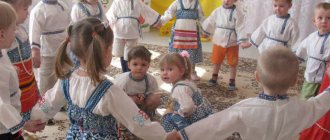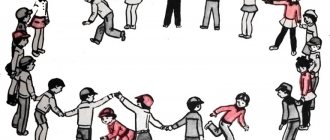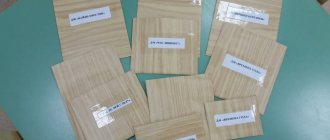Tips for parents
Children playing together with their parents benefits both. Children experience joy and bright emotions, and adults can get to know their child better and become closer to him. This is important in order to make childhood unforgettable and interesting for the child. Therefore, do not be lazy to play with him, do not be afraid to seem frivolous and funny, be a friend to him.
The games discussed in the article can be played both in the yard of the house and in a preschool or summer camp.
If you liked the article, please share a link to it
Outdoor games for a walk in winter
- Snow carousel - pupils - snowflakes. They hold hands and walk in a circle around the snowman, gradually increasing their speed. After several circles, the teacher reports that the wind has changed and the snowflakes have changed direction. The guys repeat their actions, but in the other direction. After the words “the wind has died down, snowflakes are falling to the ground,” the guys open their arms and squat.
- Funny boys – the guys line up on one side of the site, opposite the snowdrift. The catcher stands to the side. Children say:
They must run to the other side and hide behind a snowdrift. The catcher's task is to catch the children. - Blizzard - children stand in a column and join hands. Ahead, the teacher is a snowstorm, leading the children through obstacles, snowdrifts, confusing their tracks and passing like a snake between the trees. The goal of the guys is not to loosen their hands.
- Freezing – on one side of the site there is a house where the players stand. The second one is marked at some distance, the guys must run there. In the center of the site is Frost. He says:
While the children are running to another house, Frost needs to make the kids as happy as possible. - Chains - two teams of guys stand opposite each other with their hands clasped. One team calls the player's name. He must run between the other two so that they unclasp their hands. If it succeeds, he takes one into his team, if it fails, he stands between them.
Story games walk
- Butterflies - children in the role of butterflies, a teacher with a net, says:
- Let's wrap the thread - children in a line, teacher in front. Children are invited to become threads and wind themselves on a spool. Everyone follows the teacher, spinning in a circle, saying:
- Crows - the children pretend to be crows.
- Bees – children turn into bees, flap their wings and run around the playground. The teacher plays a bear:
The bees are buzzing, the bear is catching up with them. - cat house – lay out watering cans, ladles, buckets. Children stand in a line and say:
The teacher rings the bell, the children take the attributes and run to extinguish the makeshift house. At the end they say:
Outdoor games can be focused on running and activity, or they can be combined with role-playing games, when the child transforms into a hero. In this case, time on the playground will fly by quickly and interestingly.
Precautionary measures
An adult who organizes outdoor games for children must clearly know the rules and essence, certain movements, in order to be able to easily explain them to children. Before the start of the game, it is necessary to inspect the site, check special devices, equipment, benches, stands for damage and breakage. Children's shoes and clothing should be appropriate for their age and season, not restrict movement or loosen.
During the game, the adult must organize the children so that they do not injure themselves and each other. You need to instruct your child that when jumping and dismounting, you need to land lightly on your toes, crouching slightly. This will compensate for the body's load on the legs.
It is important to alternate active, energetic games with calm and intellectual games. In the summer, it is better to play in a place on the site where there is shade and coolness. In winter, you need to jump and run more to keep warm.
After the games are over, you need to check how the children are feeling and collect sports equipment and toys. Even though children are warmed up, they should not be given cold water to drink or allowed to walk around undressed in cool weather.
Outdoor games in the middle group during a walk
- Wolf - they choose a wolf. He sat down and pretended to be dozing. Children say:
The wolf is trying to catch the children. - Cook - the children stand in a circle, the driver stands behind the circle with a chef’s hat. Children say:
- Take it quickly - upon a signal from the teacher, children must bring certain objects (cones, cubes) and quickly run back.
- Where were you - The guys are divided into two groups. Each agrees on what they will show. A dialogue takes place:
Some show, others guess the actions that children perform. Then they change roles. - From the hummock , the teacher lays out the hoops on the asphalt. Children must jump from hoop to hoop. Those who never fail win.
Outdoor games in the younger group during a walk
- Song of the dragonfly – the children recite the rhyme and accompany it with movements.
- Bubble – the guys hold hands in a circle with their heads bowed. Then the words are spoken.
- Cat on the roof – one of the playing cats, he sits on a bench with his eyes closed. Children - mice, quietly sneak towards the cat, saying:
The cat wakes up and runs to catch mice. The mice can run to the line - their house, where the cat will not catch them. - Don’t stay on the floor - the catcher must, on command, catch the children, and they hurry to climb to a hill, then the catcher cannot touch them. Children cannot stay on high ground for long.
- Pigeon - the hostess, the hawk, is chosen. The rest of the children are pigeons.
Outdoor games in the preparatory group during a walk
- A homeless bunny - a hunter catches up with a hare. The animal can jump into a house (a hoop or a circle drawn in chalk) to the hare already standing in it. In this case, the bunny must run away from the house.
- Paints – a monk is selected, who moves away from the “paints” at a certain distance and turns away. The guys choose who will use which paint. Then the monk comes and knocks. - Who's there? - Monk. - What do you need? - Paint. - Which one? The monk names the color. If it is absent, it leaves; if it is present, it catches up with the child who chose this color.
- Pike and crucian carp - one player will be a pike, the rest are divided into stones and crucian carp. “Pebbles” form a circle, “crucian carp” swim inside it. When the teacher says “Pike”, the “fish” swims into a circle and begins to catch “crucian carp”, which need to sit down behind the “pebbles”. The “pike” only catches those who did not have time to hide.
- Don't get caught! – put the cord in the form of a circle or draw a circle with chalk. The players stand behind the circle at a distance of a step. The driver stands in the center, and the children jump in the circle and back. The driver's goal is to touch the child who will jump into the circle.
- Run to the tree - the teacher names the tree, and the children must find it on the playground and quickly run. So the guys run from one tree to another. The one who makes a mistake and runs up to the wrong tree is eliminated.
Walking card index of games
- Kite and hen - the kite catches the chickens, the hen protects.
- Who can line up the fastest - each group of children has their own object, which the teacher moves while the children are running. You need to have time, at the signal, to line up in a column near your object, which has yet to be found.
- Owl - one child is an owl, the rest are birds. The owl sleeps during the day and catches birds at night.
- Tag - after the signal, the driver catches the children while they are running away.
- Change of places - teams are in ranks, running towards each other and trying to line up again. The one who becomes faster wins.
On one leg along the path
Invite the children to stand on the edge of the area and jump to the middle on their right foot (3-4 meters). The children must come running back. Then let them jump on their left foot, etc.
Traps on one leg
Select a trap. At the presenter’s signal “One, two, three! Catch it!” children must run around the playground - the trap catches the players by touching them with their hand. Take those caught aside. Repeat the game 3-4 times. You cannot catch someone who managed to stand on one leg in time and clasp his knee with his hands. When 3-4 players have been caught, select a new trapper.
Tulking on one leg
Invite the children to disperse around the playground and close their eyes (everyone has their hands behind their backs). Go around the players and quietly place a handkerchief in the hands of one of them. On the command “One, two, three! Look!" children should open their eyes and look carefully at each other: who is the tag? The child who received the handkerchief should raise it up and say: “I’m a tag!” Jumping on one leg, try to get away from the tag. The player he touches becomes a tag. He must take a handkerchief, raise it up and say: “I am a tag!” Then the game repeats.
You can jump alternately on your right and left legs; when the tags are changed, the players are allowed to stand on both feet; The tag must also jump, like everyone else playing, on one leg.
Two frosts
On opposite sides of the site, mark two cities and, dividing into two groups, position yourself in them. Select and place the Morozov brothers in the middle of the site. Frost Red Nose and Frost Blue Nose should address the players:
We are two young brothers, Two Daring Frosts: I am Red Nose Frost, I am Blue Nose Frost. Which of you will decide to set out on the little path?
Guys (in unison):
We are not afraid of threats, And we are not afraid of frost.
Children should start running from one “city” to another, and Frosts should start catching them. The one they manage to catch is considered frozen. He remains in the place where he was caught, and, with his arms outstretched, blocks the path of the players during the next dashes. When there are so many frozen that it becomes difficult to run through, the game ends. The winners are those who have never been frozen.
Together one rope (fun competition)
In pairs, sit each on your own chair with your back to each other at a distance of 2-3 meters. Stretch a rope under the chairs. At the signal, jump up, run around both chairs twice, sit on yours, bend over and pull the rope. Whoever grabs it faster will win. You should run clockwise. You cannot touch chairs while running.
Before you start playing, do a rehearsal. To prevent the players from making a mistake and grabbing the rope ahead of time, count the revolutions: “One, two!” After the count of two, sit on a chair and pull out the rope.
"Do not snooze!"
Choose a presenter. Form a circle, holding the rope at the top with both hands. While the leader walks in a circle, saying the words: “Don’t sleep, don’t yawn, quickly remove your hands!”, trying to touch the players’ hands, remove them, releasing the rope in time. As the game progresses, the rope should not fall to the ground, so as soon as the leader moves away, immediately take the rope. The one whom the presenter insulted changes roles with him.
Traffic light
Material:
circles with a diameter of 10 centimeters in red, green and yellow, which are attached to sticks.
Line up the children and instruct them to perform exercises according to the leader’s signals: sit down on a red signal, stand on a yellow signal, march in place on a green signal. While moving in a column one by one around the site, change the exercise: red - stand still, yellow - move in a squat, green - jump on your toes.
For each mistake, players are awarded penalty points. The one who scores fewer penalty points wins.
Rainbow
Use a counting book to choose the player who will be the rainbow. Place him facing the players, with his arms out to the sides (he remains in his place throughout the game).
The rainbow must name a color, and the players must find it in the clothes of themselves or one of their neighbors (you can hold on to the clothes of others) and, touching this color, walk under the rainbow (under his hands). If the player does not have the desired color and cannot touch it, he must quickly run under the rainbow's hands. If he insults the player, he becomes a new rainbow and the game continues.
Treasure
This game can be played on the site or indoors.
Select the treasure hunter and take him aside. In the meantime, hide some objects in a remote corner of the site, call the treasure hunter and give him the following task: “Go straight, you will reach a tree stump, turn right from it, reach a fence, then turn left, walk three steps straight and start looking - in there is a treasure in that place.” If necessary, repeat the route description to the treasure hunter. When the player finds the treasure, select a new treasure hunter and repeat the game.
Little frogs and heron
Draw circles on the site - houses (according to the number of players). Select the heron; she hides to the side. The rest of the players are frogs, located in their houses (circles). With the words: “We sat in the mud for a long time and didn’t go out for a walk. Get out of the pond, everyone come out here,” imitating the movements of the frogs, jump out of your houses and have fun. A heron with the words: “Who is croaking here? Run away in all directions!” - begins to catch frogs. The baby frogs must hide from the heron in their houses.
Wattle
This game requires musical accompaniment - slow and fast music. Line up the players holding hands along the four walls of the court. First turn on slow music - all the ranks converge in the center and bow to each other. Then fast music - the children begin to dance. As soon as the music stops, all participants must return to their seats in their ranks. The line that lines up first wins.
Fun arithmetic
Stand in a circle. At the leader’s command, for example, “eight,” start throwing the ball and calling out the numbers that add up to eight. For example, say “Three” and throw the ball to another player. He must catch it and answer: “Five,” etc. You can immediately move on to another number, or you can list all the numbers that add up to eight. Name any numbers depending on the level of knowledge of the children. You can also speed up the pace of the game. If a player makes a mistake several times, he is eliminated from the game.
Traps-2
Divide the play area into two parts. Choose two players - traps. Line up the rest of the children on one side of the site and draw a line in front of them and on the opposite side of the site. Place the traps in the middle, between the two lines. Say the words: “One, two, three! Catch it!” - and run to the other side of the site (beyond the line), trying not to fall into the traps. If the trap touches the player before he crosses the line, the player is considered caught and moves aside. After two or three such runs, count those caught. Decide in advance which players caught will be the traps.
Sparrows and crows
Divide into two teams: sparrows and crows. Choose a presenter. Draw two lines on the ground, twenty steps from one another - nests for teams.
Line up in two rows at an equal distance from the nests, facing your nest, with your back to your opponent, and wait for the signal. After the presenter exclaims “Crows!” The crows should rush headlong towards their line, and the sparrows, instantly turning around, should run after them, trying to get rid of them. Remember or note the number of salted ones.
Then give the command to the sparrows to fly to the nest. And among them there will be losers who were overtaken by the crows. Repeat the dashes several times.
The presenter does not have to call the commands strictly in order - it is more interesting to unexpectedly call one of them several times in a row. The only important thing is that the total number of flights of sparrows and crows ends up being the same.
And one more thing: to add more tension to the game, pronounce the team names syllable by syllable. It sounds: “Vo-ro-...” - and everyone is wondering whether they will have to rush forward or back.
Just burners
Stand holding hands, one couple after another, and in front of everyone is the one who, by lot, got to burn. He can't turn back. Those standing in the last pair on the count of “three” must separate their hands, run forward and try to connect again, running around the burning one to the left, the other
on right. The one who is burning must chase those running, and if he manages to catch someone, he should become the first pair with the one caught, and the one who is left alone will burn. If the person who is burning fails to catch anyone, the same couple stands in front of the others, and he burns again.
Bunny
Choose a bunny and dance around it. Let the bunny dance all the time, looking to jump out of the circle, and let the round dance go around, singing:
Bunny, dance, Gray, jump, Turn in a circle, sideways, Turn in a circle, sideways! Bunny, clap your hands, Gray, clap your hands, Turn in a circle, sideways, Turn in a circle, sideways! There is somewhere for the hare to jump out, There is somewhere for the gray one to jump out, Turn around, sideways, Turn around, sideways!
Periodically, in different places of the round dance, loosen your hands, indicating where the bunny can slip through. The bunny must crouch to the ground, looking for a place where he can break through, and run where he was not expected.
Outdoor games in the senior group during a walk
- Freeze - at the teacher’s command “Freeze”, the children must stop and take the position shown on the card by the teacher. Failed - the player is eliminated.
- Run quietly - the driver stands, turning to the tree. When he turns around, the guys freeze. Whoever moves is out. The goal is to quietly run up to the driver and touch him with your hand.
- Traps - the trap, on command, must make other children look bad. If a child stands on one leg, holding the other knee with his hands, then he cannot be salted.
- Trap - children join hands to form a circle. They are a trap. There is a hunter, the rest are forest animals. Children run under the trap and then run out of it. At the hunter’s command “Stop,” the guys lower their hands, slamming the trap. The “animals” in the trap must make the sounds of their animal, the hunter guesses. If you guessed it right, you’re leaving. No - you become a “trap”.
- Squirrels - children put ribbons in their belts and run away on command. The catcher must collect as many ribbons as possible.







